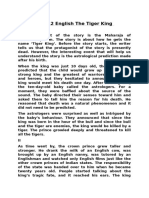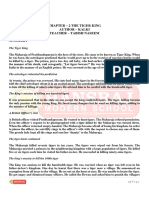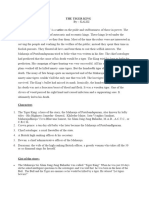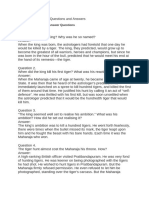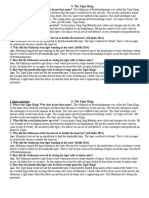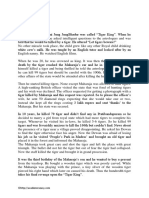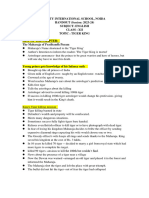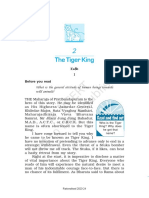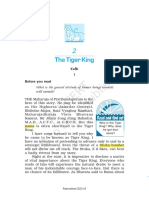0 ratings0% found this document useful (0 votes)
141 viewsThe Tiger King
The Tiger King
Uploaded by
janebro8827The story revolves around the Maharaja of Pratibandapuram whose death by a tiger was foretold at birth. Determined to prove the astrologers wrong, the Maharaja hunted and killed 99 tigers but struggled to find the 100th. When a tiger was finally found, the Maharaja shot but only wounded it. He believed he fulfilled the prophecy until he later died from infection caused by a sliver from a wooden toy tiger given to his son. Thus, the prophecy was ironically fulfilled.
Copyright:
© All Rights Reserved
Available Formats
Download as PDF, TXT or read online from Scribd
The Tiger King
The Tiger King
Uploaded by
janebro88270 ratings0% found this document useful (0 votes)
141 views1 pageThe story revolves around the Maharaja of Pratibandapuram whose death by a tiger was foretold at birth. Determined to prove the astrologers wrong, the Maharaja hunted and killed 99 tigers but struggled to find the 100th. When a tiger was finally found, the Maharaja shot but only wounded it. He believed he fulfilled the prophecy until he later died from infection caused by a sliver from a wooden toy tiger given to his son. Thus, the prophecy was ironically fulfilled.
Original Title
THE TIGER KING
Copyright
© © All Rights Reserved
Available Formats
PDF, TXT or read online from Scribd
Share this document
Did you find this document useful?
Is this content inappropriate?
The story revolves around the Maharaja of Pratibandapuram whose death by a tiger was foretold at birth. Determined to prove the astrologers wrong, the Maharaja hunted and killed 99 tigers but struggled to find the 100th. When a tiger was finally found, the Maharaja shot but only wounded it. He believed he fulfilled the prophecy until he later died from infection caused by a sliver from a wooden toy tiger given to his son. Thus, the prophecy was ironically fulfilled.
Copyright:
© All Rights Reserved
Available Formats
Download as PDF, TXT or read online from Scribd
Download as pdf or txt
0 ratings0% found this document useful (0 votes)
141 views1 pageThe Tiger King
The Tiger King
Uploaded by
janebro8827The story revolves around the Maharaja of Pratibandapuram whose death by a tiger was foretold at birth. Determined to prove the astrologers wrong, the Maharaja hunted and killed 99 tigers but struggled to find the 100th. When a tiger was finally found, the Maharaja shot but only wounded it. He believed he fulfilled the prophecy until he later died from infection caused by a sliver from a wooden toy tiger given to his son. Thus, the prophecy was ironically fulfilled.
Copyright:
© All Rights Reserved
Available Formats
Download as PDF, TXT or read online from Scribd
Download as pdf or txt
You are on page 1of 1
22
VISTAS MIND MAP
SUMMARY OF THE STORY
The story revolves around the Maharaja of Pratibandapuram, Jilani Jung Jung Bahadur, whose death at the hands of a tiger had
been foretold by astrologers when he was born. The story is a satire on the pride and stubbornness of those in power.
Soon after he was born, the astrologers predicted that one day the Tiger King would grow up to be a great warrior but he would
have to meet his death. As the astrologers uttered these words, a miracle took place. The ten-day old child said that all those who
are born are meant to die someday. He wished to know the cause of his death. The Chief astrologer said that he was born in the
hour of the bull. The bull and the tiger are enemies; therefore, his death would come from a tiger.
The crown prince grew taller and stronger with each passing day. He was brought up like an Englishman, under the influence of
western culture. At the age of twenty, the State came into his hands.
Soon the Maharaja searched and killed his first tiger to show his superiority and rebellion against fate. Considering this to be
his victory over his destined future, he called upon the state astrologer. The latter informed him that he had no life threat from
the first ninety-nine of his hunted tigers but it was the hundredth one that he needed to protect himself from. Nevertheless, the
Maharaja decided to kill at least hundred tigers as a challenge against this foretold destiny.
The State banned tiger hunting by anyone except the Maharaja. A proclamation was issued stating that if anyone dared to even
hurt a tiger, all his property would be confiscated by the State. In keeping with this vow, the Maharaja outrightly denied even a
British official, “durai,” who desired to hunt down a tiger.
Within ten years, the Maharaja managed to kill seventy tigers. The tiger population became extinct in the forests of Pratibandapuram.
The Maharaja called the dewan and expressed his desire to get married to a girl from a royal family belonging to a State with
a large tiger population. The dewan followed his orders and the Maharaja got married to such a girl. Jung Jung Bahadur killed
five or six tigers each time he visited his father-in-law. In this way, he was able to kill ninety-nine tigers. Now that he had killed
ninety-nine tigers, he was more anxious to kill the last one. By this time, the tigers had become extinct even in his father-in-law’s
kingdom. The Maharaja was eager to kill the hundredth tiger and then he could give up tiger hunting altogether. He was sunk
in gloom as the hundredth tiger could not be found. However, one day when he heard that the sheep began to disappear in his
own state, hope returned to him. He was so thrilled that he even announced a three-year exemption from all taxes for that village
and set out on the hunt. But the hundredth tiger was not easily found. The Maharaja got so furious that many officers lost their
jobs. One day, he was so enraged that he ordered the dewan to double the land tax. The dewan figured that if the Maharaja did
not find the tiger soon then it would have a bad impact on the kingdom. He was relieved to see the tiger which had been brought
from the People’s park in Madras and was kept hidden in his house. At midnight, the dewan and his aged wife dragged the tiger
to the car and drove it straight to the forest where the Maharaja was hunting. The tiger wandered into the Maharaja’s presence
and he shot the beast with boundless joy. The tiger fell on the ground. The Maharaja was so ecstatic that he ordered the tiger to
be brought to the capital in grand procession.
After the Maharaja left, the hunters found out that the tiger was not dead at all. The Maharaja had missed the target. The tiger had
just fainted from the shock of the bullet that was fired at it. However, out of the fear of losing their jobs, everyone decided not to
tell the Maharaja about this. Finally one of the hunters shot the tiger dead and they took it in a procession through the town and
buried it. A tomb was erected over it.
Maharaja quit hunting forever after this hundredth ‘kill’. A few days later, he decided for a grand celebration of his son’s third
birthday. As a gift, he decided to buy a toy tiger for his son which, unknown to him, was of poor craftsmanship.
While playing with his son one day, a tiny sliver of the rough wooden surface pierced his right hand and he died of infection. Thus,
ironically the fateful hundredth tiger, though a wooden one, was the cause of the Maharaja’s death and proved the prediction of
the astrologers correct.
1. THE TIGER KING
by Ramaswamy Aiyer Krishnamurthy
CHARACTER SKETCH: The King
The Maharaja of Pratibandapuram was called the Tiger King. At his birth, astrologers predicted his death because of a tiger. But
the baby had something miraculous about him. He was only of ten days when he challenged the prediction of the astrologers and
asked them the manner of death.
The Crown Prince was brought up in an English environment. He grew up tall, sturdy, brave and deserved to be called a Maharaja
in every case. He became the king of his state at the age of twenty and was determined to fulfill his pledge. He was strong enough
to kill the wild tigers with his bare hands. Being a man of firm determination and self-respect, he stood against a British officer by
refusing him permission to hunt in his forest. He was cunning to arrange his marriage with a princess whose father’s forest had
the maximum number of tigers. Yet he appears to be powerless before fate because this powerful king was finally killed by a sliver
from a worthless wooden tiger! His death brought him great shame. His boldness, cunning, strength and bravery failed miserably
at the hands of an insignificant wooden tiger. He can also be laughed at for believing the astrologers blindly, for the dereliction of
duty as a king, for imposing tax on the villagers out of rage, for forgetting the sanctity and meaning of marriage and for dismissing
his officers for no official reason. Thus, it can be said that the king was highly conceited and lacked worldly wisdom.
You might also like
- Understanding The SelfDocument8 pagesUnderstanding The Selfcrissanta marcelo67% (6)
- Approximating The Shapiro-Wilk W-Test For Non-NormalityDocument3 pagesApproximating The Shapiro-Wilk W-Test For Non-NormalityOsman HamdiNo ratings yet
- Class 12th L 2 Prose Vistas The Tiger King Q & ADocument9 pagesClass 12th L 2 Prose Vistas The Tiger King Q & Aankita07rNo ratings yet
- Tiger KingDocument12 pagesTiger Kingsudarshanpadhy9No ratings yet
- Summary of Tiger King-1Document4 pagesSummary of Tiger King-1Nivea MitraNo ratings yet
- 12th English Ch.2 The Tiger KingDocument3 pages12th English Ch.2 The Tiger KingRachit KumarNo ratings yet
- The Tiger King Chapter-2 VistasDocument6 pagesThe Tiger King Chapter-2 VistasSunil rathi0% (1)
- The Tiger King - VeeshalDocument21 pagesThe Tiger King - VeeshalᏉᏋᏋᏕᏂᏗᏝ Ꮄ. ᏰᎧᎴᎧᏕᏗNo ratings yet
- CBSE Class 12 English The Tiger King SummaryDocument4 pagesCBSE Class 12 English The Tiger King SummarySourajit MukherjeeNo ratings yet
- Vistas-Ch-2-The Tiger KingDocument9 pagesVistas-Ch-2-The Tiger Kinganaishagarg254No ratings yet
- Lesson 2 The Tiger KingDocument3 pagesLesson 2 The Tiger KingchoudharysaaabNo ratings yet
- The Tiger KingDocument3 pagesThe Tiger Kingfaahiya2807No ratings yet
- The Tiger KingDocument21 pagesThe Tiger KingᏉᏋᏋᏕᏂᏗᏝ Ꮄ. ᏰᎧᎴᎧᏕᏗNo ratings yet
- The Tiger KingDocument6 pagesThe Tiger KingvijayalakshmiNo ratings yet
- The Tiger King - Revision NotesDocument6 pagesThe Tiger King - Revision Notesarchanabhattarai235No ratings yet
- The Tiger KingDocument3 pagesThe Tiger KingyadavmunnavNo ratings yet
- Extra Questions - The Tiger KingDocument2 pagesExtra Questions - The Tiger KingNikunj GuptaNo ratings yet
- The Tiger KingDocument6 pagesThe Tiger Kingdakshrwt06No ratings yet
- 07Document4 pages07shreyasinghchampNo ratings yet
- Tiger King EngDocument6 pagesTiger King EngVipul PASINo ratings yet
- CH - 2 - THE TIGER KING - Docx1688051450-SmsDocument2 pagesCH - 2 - THE TIGER KING - Docx1688051450-SmsAnanya SamantaNo ratings yet
- The Tiger King Question AnswersDocument6 pagesThe Tiger King Question AnswersSRISHTI bcomNo ratings yet
- The Tiger King - Kalki-: Short Answer QuestionsDocument3 pagesThe Tiger King - Kalki-: Short Answer Questionsshahin appuNo ratings yet
- V-2 The Tiger KingDocument5 pagesV-2 The Tiger Kingmohitraghav15037No ratings yet
- Class 12 Vistas Lesson 2 The Tiger KingDocument10 pagesClass 12 Vistas Lesson 2 The Tiger King502 Jainul ShaikhNo ratings yet
- The Tiger King - Notes & QuestionsDocument5 pagesThe Tiger King - Notes & QuestionsmoiiifitbituserNo ratings yet
- Tiger KingDocument8 pagesTiger Kingswarnjeet2006No ratings yet
- English Holiday Homework: Name: Priyamvada Singh Class: 12 C Enrolment No.: IIS/2018/11462 Roll No.: 12348Document10 pagesEnglish Holiday Homework: Name: Priyamvada Singh Class: 12 C Enrolment No.: IIS/2018/11462 Roll No.: 12348baisa100% (1)
- The Tiger KingDocument1 pageThe Tiger KingMehak SinghNo ratings yet
- Tiger KDocument5 pagesTiger KatulkshenoyNo ratings yet
- The Tiger King - QUESTION - ANSWERSDocument2 pagesThe Tiger King - QUESTION - ANSWERSAnushka JaiswalNo ratings yet
- 12 English Core Ncert Vistas Ch02 The Tiger King Ans WpoansxhDocument3 pages12 English Core Ncert Vistas Ch02 The Tiger King Ans WpoansxhRitikaNo ratings yet
- The Tiger KingDocument2 pagesThe Tiger Kinglokeshelumalai38No ratings yet
- The Tiger King PDFDocument52 pagesThe Tiger King PDFAnonymous OITciJmAJ4100% (2)
- Vistas 1Document11 pagesVistas 1Maya NairNo ratings yet
- The Tiger KingDocument4 pagesThe Tiger KingLatha ChokkuNo ratings yet
- The Tiger King (English Core) Class 12 I.Com. A.B.M. CollegeDocument9 pagesThe Tiger King (English Core) Class 12 I.Com. A.B.M. CollegeswagataNo ratings yet
- 4312610-The Tiger King - QN B 2024Document10 pages4312610-The Tiger King - QN B 2024saniyamoyeed78No ratings yet
- Chapter 2Document7 pagesChapter 2REX GAMINGNo ratings yet
- Gtrade Xii Tiger King NotesDocument2 pagesGtrade Xii Tiger King NotesJ.Abishek SundarNo ratings yet
- Tiger KingDocument8 pagesTiger KingSayali SinghalNo ratings yet
- The Tiger KingDocument2 pagesThe Tiger Kingaaryantak149No ratings yet
- Tiger King - NotesDocument3 pagesTiger King - Notes03.1819.betinaNo ratings yet
- The Tiger KingDocument10 pagesThe Tiger KingsafafasfasfasfsafNo ratings yet
- Class 12 Sample Paper EnglishDocument7 pagesClass 12 Sample Paper Englishpalak yadavNo ratings yet
- The Tiger KingDocument3 pagesThe Tiger Kingannthomas1428No ratings yet
- NCERT Solutions For Class 12 Vistas English The Tiger King-1Document3 pagesNCERT Solutions For Class 12 Vistas English The Tiger King-1infinityNo ratings yet
- The Tiger King by KalkiDocument3 pagesThe Tiger King by KalkiS.Harish ChinnuNo ratings yet
- Tiger KingDocument40 pagesTiger KingHome Grown CreationNo ratings yet
- Class 12 Chapter 2 The Tiger KingDocument7 pagesClass 12 Chapter 2 The Tiger Kinghimanshukumbhakar56No ratings yet
- The Tiger King NOTESDocument6 pagesThe Tiger King NOTESDieHard TechBoyNo ratings yet
- The Tiger King Important Questions Long Answer Type QuestionsDocument3 pagesThe Tiger King Important Questions Long Answer Type Questionscodoja2214No ratings yet
- English Vistas Chapter 2 - The Tiger KingDocument10 pagesEnglish Vistas Chapter 2 - The Tiger KingPushpit GillNo ratings yet
- Levt 102Document10 pagesLevt 102XYZNo ratings yet
- Class 12 English Vistas Chapter 2Document4 pagesClass 12 English Vistas Chapter 2Sahabdeep SinghNo ratings yet
- English P Ro Je CT WorkDocument15 pagesEnglish P Ro Je CT WorkMilap BaraiNo ratings yet
- Vistas CH 2 The Tiger King Q-AnsDocument12 pagesVistas CH 2 The Tiger King Q-AnsDivyam PatelNo ratings yet
- Class XII English CH 6 The Tiger KingDocument24 pagesClass XII English CH 6 The Tiger KingSuprio ChakrabortyNo ratings yet
- Tiger King Cbse LessonDocument5 pagesTiger King Cbse LessonSanthosh ImpressionnantNo ratings yet
- Chapter 2 The Tiger KingDocument3 pagesChapter 2 The Tiger Kingajoysaha87No ratings yet
- Lesson 10Document2 pagesLesson 10akokpanasNo ratings yet
- ASTM C1609 - C1609M - 19a Standard Test Method For Flexural Performance of Fiber-Reinforced Concrete (Using Beam With Third-Point Loading)Document5 pagesASTM C1609 - C1609M - 19a Standard Test Method For Flexural Performance of Fiber-Reinforced Concrete (Using Beam With Third-Point Loading)ming_zhu10No ratings yet
- 7 - Ideation and PrototypingDocument44 pages7 - Ideation and PrototypingHasnain AhmadNo ratings yet
- Grammar in Use Translation MethodDocument14 pagesGrammar in Use Translation MethodsartikaNo ratings yet
- PRINTEACH MOD2 - SS'Document18 pagesPRINTEACH MOD2 - SS'Richard John Dela CruzNo ratings yet
- Purchase Money MortgageDocument6 pagesPurchase Money MortgageJames Bradley Stoddart100% (1)
- Seminar: Mentoring Teacher Researchers: Saturday, 7 September, 0930-1700 HoursDocument1 pageSeminar: Mentoring Teacher Researchers: Saturday, 7 September, 0930-1700 HoursJasti AppaswamiNo ratings yet
- Medha Patkar NYCposterDocument1 pageMedha Patkar NYCposterdrstrangelurveNo ratings yet
- Unit 1 An Overview of Ethics, Ethics For IT Workers and IT UsersDocument34 pagesUnit 1 An Overview of Ethics, Ethics For IT Workers and IT UsersPiyush KoiralaNo ratings yet
- Hark The Herald Angels Sing / King of Heaven: F F F FDocument1 pageHark The Herald Angels Sing / King of Heaven: F F F FRichelle MercadoNo ratings yet
- Batl037 PDFDocument6 pagesBatl037 PDFAlshareef HamidNo ratings yet
- Virtual LaboratoryDocument14 pagesVirtual LaboratoryArie Febry Fardheny, MTNo ratings yet
- Connection 2008 SeptemberDocument8 pagesConnection 2008 SeptemberBoiseState100% (1)
- Mechanical Engineering: CAESAR II Receives TD12 Approval by TranscoDocument20 pagesMechanical Engineering: CAESAR II Receives TD12 Approval by Transcofileseeker100% (1)
- JBDocument2 pagesJBNatalijaNo ratings yet
- Vocabulary Bank 1a - What Are They LikeDocument1 pageVocabulary Bank 1a - What Are They LikeJair RomeroNo ratings yet
- AspectsDocument4 pagesAspectsClark Stillman100% (1)
- NZ Politics Daily - 4 October 2013Document244 pagesNZ Politics Daily - 4 October 2013Ben RossNo ratings yet
- Senior Assistant 5th Level AdministrationDocument9 pagesSenior Assistant 5th Level AdministrationArjun kumar ShresthaNo ratings yet
- 5 DiffusionDocument37 pages5 Diffusionrezamaulana100% (1)
- Math g7 m1 Topic A Lesson 1 Student PDFDocument3 pagesMath g7 m1 Topic A Lesson 1 Student PDFMO Customs BrokerageNo ratings yet
- 2024 Application Forms - Postgraduate Degree PDFDocument6 pages2024 Application Forms - Postgraduate Degree PDFYhèľèh MhàŕìèNo ratings yet
- DLL - English 5 - Q3 - W1Document11 pagesDLL - English 5 - Q3 - W1Gelline Corpuz GadiaNo ratings yet
- Sounds & Spelling of Irish/Fuaimeanna Agus Litriú Na GaeilgeDocument4 pagesSounds & Spelling of Irish/Fuaimeanna Agus Litriú Na GaeilgeJoy L AndersonNo ratings yet
- 8 - M (Physical) 8 - M: Period PeriodDocument1 page8 - M (Physical) 8 - M: Period Periodhafsa khalidNo ratings yet
- Fist of The ForestDocument1 pageFist of The ForestRennik McCaigNo ratings yet
- CV - Leona BogdanovicDocument3 pagesCV - Leona BogdanovicLeona BogdanovicNo ratings yet
- The Narrative Study of Self and SocietyDocument18 pagesThe Narrative Study of Self and Society吴善统No ratings yet








